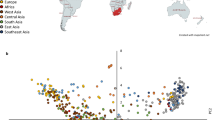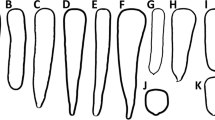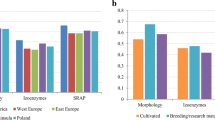Summary
Oat (Avena sativa L.) have been cultivated in China for approximately 2000 years. Little is known about the origin of Chinese oat, and Western access to this germplasm pool has been limited. The objective of this research was to compare the relative levels of genetic diversity in a sample of 119 Chinese hulled and hull-less accessions with a sample of 33 hulled Western A. sativa and A. byzantina C. Koch accessions using RAPD analysis. Seventy-two polymorphic fragments were amplified by 18 primers in the Chinese and Western accessions. The Chinese germplasm pool exhibited a lower level of diversity than the Western germplasm pool. Sixty-seven polymophic fragments were detected in Western germplasm versus 49 in Chinese germplasm. The polymorphic index for Chinese germplasm was one-half that observed for Western germplasm, and the probability of observing a phenotype in Chinese germplasm that was not present in Western germplasm was one- tenth the reciprocal probability. A 152 × 152 relationship matrix of all pairwise combinations of the Chinese and Western accessions was constructed based on Jaccard’s distance estimates. The results suggested that the Chinese accessions, especially the hulled types, had a greater affinity with the nineteenth century A. sativa germplasm pool of northern and central Europe than with recent North American spring- and fall- sown cultivars, or the A. byzantina cultivars of Mediterranean origin.
Similar content being viewed by others
References
Coffman, F. A., 1977. Oat history, identification and classification. USDA-ARS Tech. Bull. No. 1516. U.S. Gov. Print. Office, Washington, DC.
Doyle, J. J., & J. L. Doyle, 1987. Isolation of plant DNA from fresh tissue. Focus 12:13–15.
Hedrick, P. W., 1971. A new approach to measuring genetic similarity. Evolution 25:276–280.
Hsu, C, 1980. Han Agriculture. Univ. Washington Press, Seattle, Washington.
Jellen, E. N., & J. K. Beard, 1999. Geographic distribution of a 7C/17 intergenomic translocation in cultivated oat. Crop Sci. 40:256–263.
Jenkins, G., & P. R. Hanson, 1976. The genetics of naked oats (Avena nuda L.). Euphytica 25:167–174.
Kruskal, J. B., 1964. Multidimensional scaling by optimizing goodness of fit to a non-metric hypothesis. Psychometrika 29:1–27.
Nei, M., & A. K. Roychoudhury, 1974. Sampling variance of heterozygosity and genetic distance. Genetics 76:379–390.
O’Donoughue, L. S., E. Souza, S. D. Tanksley, & M. E. Sorrells, 1994. Relationships among North American oat cultivars based on restriction fragment length polymorphisms. Crop Sci. 34:1251–1288.
Phillips, T. D., & J. P. Murphy, 1993. Distribution and analysis of isozyme polymorphism in North American cultivated oat germplasm. Crop Sci. 33:460–469.
SAS Institute, 1992. Technical Report P-229. SAS Institute, Inc., Cary, North Carolina.
Souza, E., & M. E. Sorrells, 1989. Pedigree analysis of North American cultivars released from 1951 to 1989. Crop Sci. 29:595–601.
Souza, E., & M. E. Sorrells, 1991a. Relationships among 70 North American oat germplasms: I. Cluster analysis using quantitative characters. Crop Sci. 31:599–605.
Souza, E., & M. E. Sorrells, 1991b. Relationships among 70 North American oat germplasms: II. Cluster analysis using qualitative characters. Crop Sci. 31:605–612.
Stanton, T. R., 1923. Naked oats. J. Hered. 14:177–183.
Stanton, T. R., 1961. Classification of Avena. In: F. A. Coffman (Ed.), Oats and oat improvement, pp. 75–111. ASA, Madison, Wisconsin.
Thomas, H., 1995. Oats. In: J. Smartt & N. W. Simmonds (Eds.) Evolution of crop plants, pp. 132–140. Longman Group, New York.
Valentine, J., 1995. Naked oats. In: R. W. Welch (Ed.), The oat crop, pp. 504–532. Chapman and Hall, New York.
Vavilov, N. I., 1926. Studies on the origin of cultivated plants. Inst. Appl. Bot. and Plant Breed., Leningrad, Russia.
Williams, J. G. K., A. R. Kubelik, K. J. Livak, J. A. Rafalski, & S. V. Tingy, 1990. DNA polymorphisms amplified by arbitrary primers are useful as genetic markers. Nucleic Acids Res. 18:6531–6535.
Zhou, X., E. N. Jellen, & J. P. Murphy, 1999. Progenitor germplasm and paths of domestication in hexaploid oat. Crop Sci. 39:1208–1214.
Author information
Authors and Affiliations
Corresponding author
Rights and permissions
About this article
Cite this article
Baohong, G., Zhou, X. & Murphy, J.P. Genetic Variation Within Chinese and Western Cultivated Oat Accessions. CEREAL RESEARCH COMMUNICATIONS 31, 339–346 (2003). https://doi.org/10.1007/BF03543363
Received:
Accepted:
Published:
Issue Date:
DOI: https://doi.org/10.1007/BF03543363




